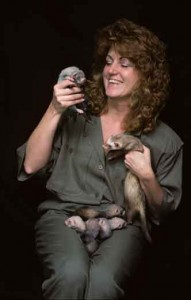The Smithsonian Mourns: Dr. JoGayle Howard, Wildlife Biologist (1951-2011)
/https://tf-cmsv2-smithsonianmag-media.s3.amazonaws.com/filer/20110520110715JoGayle.jpg)
Dr. JoGayle Howard, a world-renowned wildlife veterinarian, died Saturday, March 5 at the age of 59. She had melanoma. Howard, the subject of the upcoming Smithsonian Channel program Nature's Matchmaker, pioneered new techniques in animal reproduction. She achieved "countless breakthroughs, trained hundreds of students and foreign colleagues and played an instrumental role in saving species," reports the National Zoo, where Howard worked for three decades. Howard's reputation as an animal matchmaker and reproductive sleuth, solving the difficult issues of breeding endangered species, garnered her the sobriquet, "Sperm Queen," a nickname she relished. But her real title is that of the tongue-twisting theriogenologist, or an expert in the understanding of the physiology and pathology of animal reproduction.
Solving the problem of getting endangered animals to breed was Howard's specialty.
Perhaps Howard's most popular and visible success was one spectacular birth at the Zoo—the 2005 arrival of the giant panda cub, Tai Shan. As part of the Zoo's reproductive sciences team, Howard unraveled the mystery of the animal's unique breeding biology. The female panda is sexually receptive just once a year for a single three-day period, creating a remarkably short window of opportunity. Meanwhile, the male panda proved to be notoriously uninterested when the annual occasion occurred. Howard and her team pioneered speedy techniques for monitoring hormones in urine to predict ovulation. And once the critical moment was identified, the female panda was artificially inseminated. The techniques have resulted in the successful births of more than a dozen panda cubs worldwide.
In 2009, Howard took a look at the complexities of breeding the highly endangered clouded leopards of Southeast Asia, resulting in the births of two cubs at the Zoo's Conservation Biology Institute near Front Royal, Virginia. Clouded leopards are elusive in the wild, but scientists say that perhaps less than 10,000 remain. Breeding them in zoos proved hugely problematic because the male would often maim or kill its partner. Howard, working with colleagues in Thailand and at the Nashville Zoo, discovered an elegant solution—simply raising the mating pairs together as cubs, beginning as early as six months. The Zoo's cubs Hannibal and Jao Chu, introduced in Thailand, grew up together and arrived at the Front Royal center in February 2008.
"If we lose this species," Howard says of the clouded leopards in a recent Smithsonian Science video, "that means we probably lose other species in the forest. We may lose the forest all together. It may affect the human race eventually. I think most people want to just see these animals and want their future generations to see these animals. They are unique and nothing's going to replace a clouded leopard."
And neither will anything ever replace the Smithsonian Institution's JoGayle Howard.
Nature's Matchmaker premieres on the Smithsonian Channel March 13 at 8 PM.
/https://tf-cmsv2-smithsonianmag-media.s3.amazonaws.com/accounts/headshot/Beth_Head_Shot_High_Res-14-v2.png)

/https://tf-cmsv2-smithsonianmag-media.s3.amazonaws.com/accounts/headshot/Beth_Head_Shot_High_Res-14-v2.png)